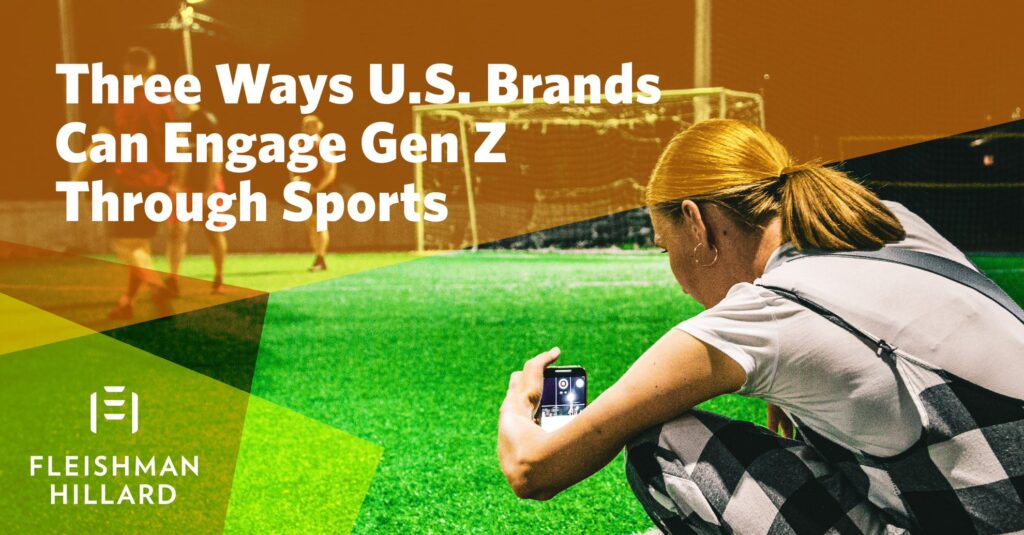Three Ways U.S. Brands Can Engage Gen Z Through Sports
Just like Millennials before them, Gen Z is one of the most continuously sought-after audiences by brands. Gen Z and Gen Alpha bring new complexities when it comes to brand engagement and their relationship to sports and media, especially compared to their predecessors. As brands in the sports space grapple with how best to engage these younger audiences, FH Sports developed actionable insights to help.
To better unpack this dynamic audience for the many brands, teams, leagues and others within the sports world that are trying to reach and engage Gen Z, FleishmanHillard’s TRUE Global Intelligence Research and Analytics practice conducted a 1,000-person survey spanning generations from Gen Z to Boomers. In this survey, we asked consumers about their relationship with sports, digging into their consumption behaviors, preferences and attitudes, all against the backdrop of an ever-evolving media landscape. These insights, coupled with FleishmanHillard’s experience in helping brands connect with key audiences with a relevant cultural context, led us to the following opportunities for sports communications and marketing professionals.
Frame Sports as Entertainment

The younger the audience, the greater they flock to pop-entertainment content over more traditional sports storytelling. Our survey found that Gen Z views entertainment content, online or offline, at the highest percentage of all topics – 48%, compared to sports content at only 23%. This is a stark contrast to older generations like Boomers, whose sports viewership was higher at 41%, 30% for Gen X and 36% for Millennials.
While Gen Z is less invested in traditional sports content compared to pop entertainment, this dynamic provides sports communications practitioners the opportunity to build storytelling strategies that bridge sports and entertainment more closely. This approach – sports as entertainment – leans into the preferences and passion points of Gen Z, igniting greater fandom and engagement potential.
A great example of this blending of sports and pop-entertainment storytelling can be found with ESPN and MiLB, both of which partnered with Marvel on separate programs. The MiLB partnership with Marvel, “Marvel’s Defenders of the Diamond,” started in 2022 and features each MiLB club hosting at least one Marvel theme night at their ballpark involving popular Marvel Super Hero character appearances, special Marvel-themed uniforms, custom Minor League Baseball-themed comic books and entertaining Marvel-themed activities and promotions at games.
Unpack Stories of Individual Athletes

Compared to other generations, Gen Z most relates to sports through the athletes. In fact, 75% of Gen Z are fans of individual athletes, compared to 59% of Boomers, 67% of Gen X and 70% of Millennials. Research indicates the interest in individual athletes is derived from Gen Z’s appreciation for the whole athlete – on and off the field. While performance certainly contributes to their fandom, Gen Z expects more from its athletes, teams and leagues when it comes to their backgrounds, beliefs and values, character and inspiring or responsible actions. This perspective is reinforced by Gen Z’s involvement and engagement on social issues.
This evolved view of the athlete – a 360 athlete – plays out in Gen Z consumption behaviors. For example, 43% of Gen Z seeks out stories about individual athletes. For brands connecting themselves to athletes, ensuring that storytelling expands beyond performance and focuses more on the athlete’s whole self will be key. Focusing storytelling on the many dimensions of athletes – from their values, personalities and interests in fashion, sneakers, gaming and technology, not only expands the types of stories that we can tell, but also can create authentic storytelling moments for brands across verticals and at the intersection of these topics and sport. This also creates more opportunities around the types of validators, influencers and creators that can be additional voices within storytelling strategies as well.
This interest in the whole athlete is why content like Complex’s Sneaker Shopping, which features athletes, musicians and celebrities shopping and discussing sneakers, is so incredibly popular. On Complex’s YouTube Channel, an episode featuring Shaq has racked up almost 5 million views. An earlier episode featuring Cristiano Ronaldo has 35 million views!
Prioritize Streaming and Gaming Channels

As streaming platforms, new media and even decentralized social spaces rise in consumption and attract younger audiences, how we reach and engage audiences must also evolve. Our research confirmed that YouTube (40%), TikTok (40%), Instagram (24%) and streaming platforms including Netflix, Hulu, and Amazon Prime (26%), are the primary places where Gen Z is consuming overall content. However, when it comes to consuming sports, we are seeing consumption by Gen Z on Twitter (24%), TV broadcast and cable (37%), and directly on brands’ websites (15%). This shows a disconnect in where Gen Z is most consuming content and where most sports content is currently living.
With that discrepancy, there’s a great opportunity to reset our channel approach to meet Gen Z where they are most frequently with sports content that is more tailored to their interests – athlete driven, created through the lens of entertainment and served up on highly video-driven social channels like YouTube and TikTok, and through gaming.

It will come as no surprise that gaming tops the list of activities that Gen Z participates in. According to our survey, 47% of Gen Z respondents said they participate in gaming, one of the highest activities among the cohort. Yet sports is only capturing 20% of Gen Z when it comes to attending a sporting event or trying a new sport or fitness activity. This further proves the explosion of gaming we’ve seen in the past few years and reinforces the role that gaming can play as a funnel to sports fandom – either through unique partnerships or storytelling. Interestingly, gaming also tops sports within preferred activities for Millennials and Gen X, showing the wider potential audience reach that can be achieved.
The NFL, with a median age of traditional TV viewers being 54 years old, is looking to recruit the next generation of football fans, specifically Gen Z. Among other efforts that explore non-linear content distribution options, including streaming Thursday Night Football on Amazon Prime and Wild Card SlimeCast on Nickelodeon, the NFL recently introduced NFL Quarterback Simulator, an experience within Roblox, the league’s second such collaboration with the platform (building on NFL Tycoon). NFL Quarterback Simulator allows Roblox users to play on “fantastical” football fields, where they attempt to obliterate themed targets with passes, while hoarding card packs and putting together an all-star team as they roam the field.
What’s Next
The power of sports is unrivaled in bringing fans of all ages together. The most successful strategy for engaging Gen Z must include an approach that integrates their other interest areas – like entertainment, authentic and compelling content that provides insight into the whole athlete and a mix of channels that meet Gen Z where they exist.
FH Sports is a global team of experienced communications professionals who live and breathe sports. From iconic to emerging, we shape the narrative for the world’s most transformative brands in sports – from sponsors and brands, to teams, leagues and governing bodies and events. Delivering data-driven, creative and memorable ideas that are designed to connect with avid and casual fans, we place our clients at the epicenter of the sports and culture conversation to drive their business forward.
For more information, please contact [email protected].
This study included 1,000 U.S. residents of age 15 to 75 from a national opt-in research panel. The survey was completed from August 2 to 9, 2022. Representation of generations includes Gen Z (n=289), Millennials (n=281), Gen X (n=249) and Boomers (n=181).

